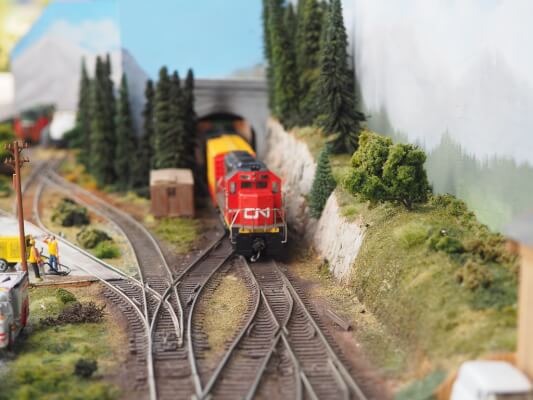When you think of model trains, picture-perfect sceneries are probably not the first thing that comes to mind. However, there is a whole world of hobbyists out there who don’t just run their trains around in circles; they spend hours making sure that their sets look great too!
One way these people make their sets more realistic and beautiful is by using plaster cloth. Plaster cloth is used for scenery purposes only, and you can apply it with paint or glue.
Are you a model train enthusiast? Let’s dive into everything you need to know about plaster cloth in model train sets.
What is Plaster Cloth?
Plaster cloth is used to make scenery and other features on model train sets. It offers many advantages over paper-and-ink or plastic printed materials because it can be easily shaped into any desired form without ripping or tearing.
Moreover, its surface texture is unique and suits different purposes; and it does not require additional solvents. Plaster cloth is used in model train sets because it helps you create beautiful sceneries.
The plaster cloth is painted to give texture and coloring. This will help to create a realistic-looking landscape. One of the advantages of using plaster cloth in model train sets is that it’s easy to maintain the tracks with it since it doesn’t require too much maintenance or upkeep.
What is Plaster Cloth Used For?
Plaster cloth is often used for detailed sceneries with mountains, valleys, fences, rocks, trees, shrubs, and grass. Model train enthusiasts often use it to make gorgeous mountainous landscapes and other complex sceneries.
What Can I Use Instead of Plaster Cloth?
Toilet paper! Yes, if you are experienced in building scenic train sets, toilet paper will do the trick. But it is a far more annoying process. Dip a piece of toilet paper in water and it will probably break into pieces when you take it out.
There are some other substitutes for plaster cloth. If you don’t mind using more than one material, you can use two pieces of fabric and glue them together to create a material similar to plaster cloth.
You can also use modeling clay to create elevations. However, this largely depends on what type of model train set you wish to make. For example, if you want to elevate the yard, you’ll need something that provides consistency. Clay is a bit squishy, and it is hard to create a uniform elevation with it.
What Makes Plaster Cloth the Better Option?
But why plaster cloth? Why don’t model train enthusiasts use plastic? The answer lies in the fact that plaster cloth is a material that can be shaped or formed to produce specific results.
Although scrap paper is often used, plaster cloth offers a more realistic look to the scenery.
People sometimes avoid using plaster cloth as it is a bit expensive. Yes, if you visit a model train enthusiast shop or similar, you’ll have to fork out a lot of money.
However, if you go to an art supplies store, you can get plaster cloth for much, much cheaper!
How Long Does Plaster Cloth Take to Dry?
Usually, it takes about 24 hours for the plaster cloth to dry fully. It is a good idea to run your finger over the cloth to check for damp areas. Leave your set to dry more till there are no damp areas.
However, if you live in a humid area, plaster cloth might take longer to dry. Make sure you check it multiple times before you start painting your scenery!
Can You Paint Plaster Cloth?
Yes, this is one of the many advantages of using plaster cloth. You can paint it without losing its textured finish. If you are painting the plaster cloth, use acrylic paint. Acrylic paints are best because they won’t fade with time.
Use a brush or roller to apply the paint to the plaster cloth. Use two or three coats of paint for better coverage. You can also use a varnish to seal the paint if you need it to be waterproof.
To make trees, shrubs, and grass, mix liquid dish soap with liquid laundry detergent in water, then spray it on the wall or other surface on which you want the foliage.
How to use Plaster Cloth
Using plaster cloth is quite straightforward. Here’s a step-by-step guide to using plaster cloth to create beautiful sceneries.
- Add underlying support, such as cardboard, crumpled newspaper or plastic balls.
- Measure and cut the cloth into smaller strips. Rectangular strips are great for almost all scenarios.
- Dip a cut piece of plaster cloth into the water. A little will do. Don’t drench it all the way!
- Gently apply the wet cloth over your desired base and spread it evenly. You can apply multiple strips to make slight elevations.
- Wait about 24 hours for the plaster cloth to dry.
- Use acrylic paint after the cloth has dried.
Now that you know how to use plaster cloth, it should be easier to create beautiful sceneries for your model train set. Don’t forget about adding accessories such as trees and shrubs made out of modeling clay!
Best of luck with your next creation! We would love to see your gorgeous sceneries in the comments below!
Meta Description:
Peter has been building model trains for longer than he can remember. An avid fan of HO and O scale this blog is a creative outlet to allow him to dive further into other scales and aspects of the model train community and hobby.
